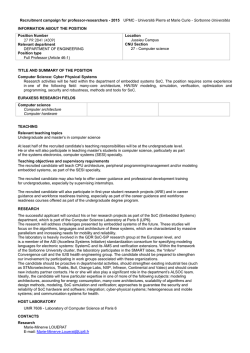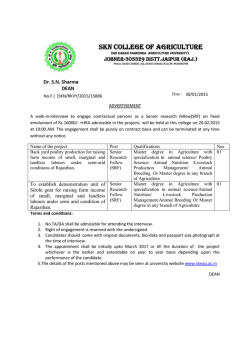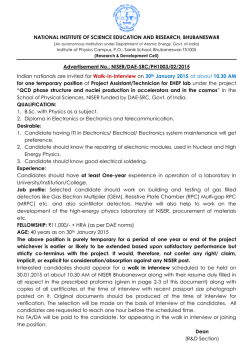
Read Full Story - helblingsearch.com
Facilitating Smooth Transitions for Newly Hired Executives By Sami L. Barry, based on interviews with Thomas J. Helbling, Marc K. Datz, and Thomas M. Dunn Studies indicate that a new executive’s performance can be significantly impacted by experiences that occur during his or her first weeks and months in a role. Therefore, it is important to implement executive transition strategies to help these leaders navigate critical issues that can affect their overall performance. The Society for Human Resource Management defines these strategies as processes by which new hires become adjusted to the social and performance aspects of their jobs quickly and smoothly, and learn the attitudes, knowledge, skills, and behaviors required to function effectively within an organization. While formal onboarding programs can be very effective, positive results can also be achieved through other less prescribed techniques. 40 to 50% of leaders fail or leave within their first 18 months in a new position. The financial cost of losing an executive in that timeframe can be about three times the leader’s first year salary. There can also be indirect losses due to increased turnover, decreased employee productivity, and the reduced credibility in a company’s leadership. Tom Helbling, an executive search consultant for more than 35 years and President of Helbling & Associates, says, “I’ve seen the difference that a formal or informal onboarding process can make on an executive’s ability to transition smoothly into a new role. An executive gets ingrained in the company and role much earlier, which many times means that he or she can make an impact much sooner. There is no doubt that when a senior leader transitions well, it’s not only better for him or her, but for the organization as a whole. When we perform searches for this level of executive, we ensure from the beginning that our clients understand their role in bringing the new executive on board, and we discuss with them how the right person can affect every aspect of their business, the dynamics of the organization, its overall morale, as well as productivity. If their current leadership embraces the new executive, and that person is engaged early on, strategies can be put into place relatively quickly and positive changes can begin to happen.” A strong executive will come in and hit the ground running? “There are several common misconceptions about newly hired executives,” says Helbling. “The most common misunderstanding is that a capable executive should be able to ‘come in and hit the ground running’. Because of his or her level of experience, long list of achievements, and success in leading a group or a company, it’s somewhat natural for the leadership team to believe this about the new executive. In reality, while some of the responsibility for performance clearly falls on the executive, a company has its own responsibilities in the transition process to appropriately support the professional’s performance. In general, organizations typically underestimate the amount of assistance, guidance, and support that needs to be provided to executives early on to assure their success.” Identifying potential issues is half the battle As search consultants, we understand that every organization is unique and has its own challenges and idiosyncrasies that can impact a leader’s transition. However, there are common situations that can hinder an executive’s early performance in a role, thus impeding long-term success. By recognizing and identifying potential problem areas before the hiring process begins, companies can prepare for and prevent many of the issues that may otherwise impede the new executive’s assimilation into the organization. Common issues include: Unrealistic timeframes to achieve certain goals. New executive’s lack of knowledge of the realities associated with the role. Main Drivers for Adopting an Executive Onboarding Process Source: Career Partners International 12% 16% 59% 8% 5% Business expense of failed leaders High turnover of key talent in the organization Cost of hiring talent Senior leadership’s inability or unwillingness to support a new executive’s initiatives. Expectation that one person can be a cure-all (i.e. overestimation of what one person can do). Ill will among colleagues who may believe they should have been given the role. Lack of authority commensurate with responsibility. High profile derailment Need to accelerate success of the leader and organization Another common issue that occurs is that a new executive has not been fully informed of the company’s internal challenges and issues during the interview process. Senior Managing Consultant Marc Datz explains, “Lower level employees tend to hide things from senior executives. When you get to the executive leadership of an organization, they typically do not know the extent of what is going on within their organization in the lower ranks. They are truly unaware of the depth of the issues, and therefore do not discuss them with potential executive hires.” Helbling says, “All of these situations are unfortunate and can hinder a new executive’s performance and impact, and prevent him or her from reaching set expectations. However, they are preventable if a company and its leadership team have open communication and are proactive in facilitating a smooth transition.” Facilitating a smooth transition begins before the executive starts High performing leadership teams understand that the hiring of a new executive and the ease of his or her subsequent transition affects the entire organization in many areas – from the team’s own credibility as leaders, to employee productivity, to reduced turnover. Therefore, open communication is the foundation of successfully onboarding a new executive. Helbling says, “A company doesn’t necessarily have to have a formal process. They just have to practice open communication with all parties. If there are issues similar to the ones stated above and we are aware of them at the onset of a search, we can discuss those issues in depth with our client and we can determine how those potential obstacles can be overcome by securing the right executive. We can also ensure that those circumstances and dynamics are outlined and discussed with final candidates. This type of open communication is necessary and a major part of our responsibilities as search consultants. Additionally, we make sure that the client has a plan for supporting the selected executive through those challenges. It’s all part of our consultative process.” “To Tom’s [Helbling’s] point, due to the fact that many of our clients have onboarding processes with varying degrees of formality and effectiveness, we have seen that sometimes an informal and flexible process can work depending on the company’s size and culture,” explains Senior Managing Consultant, Tom Dunn. “I’ve seen how a strong human resources leader can play an instrumental role in facilitating smooth transitions. Once a candidate is placed by our firm, they take over and act as our extension of influence. They do a great job at making the transition process proactive versus reactive.” Dunn goes on to say, “Throughout the search process and an executive’s transition, appropriately balancing positives and negatives, and opportunities and challenges, is critical. During the interview stage, it’s everybody’s intention to put their best foot forward and show pride in what they do. Current executives don’t necessarily want to expose their firm’s problems to someone who’s being interviewed. After all, you have to sell people to attract them. However, if you don’t outline the negatives, and a candidate thinks the opportunity is rosier than it actually is, six months later you’re going to have an issue. If you discuss the challenges with a candidate and it doesn’t deter them, you probably have the right person. As search consultants, we have to be honest about what we perceive the issues to be with all parties. For clients, it may be a candidate’s technical abilities and cultural fit. For candidates, it may be challenges that our client is currently experiencing.” As a team, Helbling consultants agree that once a final candidate is selected, there are two essential onboarding initiatives that are best done before the executive begins employment: Consider how the company’s senior leadership can actively foster the new executive’s successful integration, and outline the team’s responsibilities in helping the candidate to transition. If appropriate, explain why he or she was chosen for the role, and his or her background, skill sets and experiences. Fully debrief the executive on the culture, the challenges and positive aspects of the company, the role, and its specific responsibilities. Beyond these initial strategies, Datz says, “It makes a difference when the client maintains communication with the candidate between the time the individual accepts an offer and his or her first day on the job. Whether it’s taking the new hire to lunch or inviting him or her to come into the office to look at drawings, having people in the company reach out to the individual will make him or her feel welcome. The professional begins to get engaged, and they feel accepted before they actually start.” Datz goes further in saying, “Patience is also a part of a transitional period. What many companies don’t realize is that if the person who was in the role before was there for a long time, there were peer to peer and boss/subordinate relationships that have been severed in some way and it takes some time to repair that situation and introduce new relationships. Even the most talented executive needs to have everyone on his team pushing in the same direction.” Communication is key In closing, Helbling expresses, “I’ve been in this business a long time and I’ve placed hundreds of professionals in executive roles. There is no doubt that the executives who were onboarded effectively outperformed, by far, those who had longer or more difficult transitions into their roles. They also had the opportunities to make significant impacts earlier on, giving them confidence and motivation. When this happens, it can quickly transcend from their role to the entire organization, bringing new energy and enhancing morale. Again, while it’s extremely beneficial to have a formal onboarding program, it’s not absolutely necessary. Straightforward communication during the recruitment or search process and throughout a transition is still the most important aspect of an executive’s onboarding and of his or her ultimate success. We place numerous senior level executives with firms involved in construction, engineering, institutions, and corporations. We have a high success rate in placing executives who we know can successfully fulfill our client’s expectations and achieve their objectives. Therefore, after we place them, we go the extra mile to make sure their transitions go smoothly. It’s the only way to make sure a search is completed successfully, and that our client and the selected executive will be better for it.” Executive Transition Case Studies Below are examples of successful executive transitions. While they involve programs of varying degrees, strategies were found to be beneficial in smoothly transitioning the placed executives. New York Medical Center •Helbling recently placed the Senior Director of Capital Planning (Director) with a New York City medical center. His first few days were spent in the organization’s standard orientation program that included people who were recently hired for all different levels of positions. This gave him exposure to a broad group of people beyond his own department and leadership team. Dunn, the search consultant responsible for the Director’s placement, says, “This program provided the individual with a venue that was outside of his day-today duties and it gave him the opportunity to learn how the organization operates. While formal orientation programs are common and efficient practices for large employers to inform their employees about who they are, what they do, and how their benefits work, they go beyond accomplishing these basic tasks. When I spoke to the Director after his first week, he expressed that the orientation informed him of things he needed to know so that he didn’t have to ask his colleagues. The other nice touch was that, each day of orientation, he went to lunch with his direct report and the Human Resources leader. Those first days put him at ease and made him feel like he had time to ‘catch his breath’ before starting his actual role. He didn’t have any real expectations on his shoulders and he had time to digest the information.” Multinational Construction Firm •One of Helbling’s long-term clients is a multinational construction management firm that has numerous business units in varying regions. The company has made great strides in improving its executive onboarding process. As an example, one of its regional leaders provides a personal touch when transitioning new executives. He makes sure that all of the key players who will be interacting with the new hire calls to introduce themselves and to welcome him/her on board. Recently, Helbling placed a female executive in the company’s California office. Not only did the appropriate professionals reach out to her, but the regional leader also had some of the firm’s female executives call her to express how they like working for the firm and how the company treats them as females. They invited her to contact them if she ever has questions or concerns. The executive was impressed and conveyed her appreciation for the warm welcome, which was unexpected from such a large firm. Mechanical Contractor •Helbling worked closely with a mechanical contractor in securing the Vice President of their Fire Protection Division. The placement entailed a relocation for the secured executive and his family. During the final stages of his interview process, the company’s executives put forth extra efforts to make him feel welcome, even before he accepted an offer. They introduced him to other leaders, took him and his wife out to dinner, and provided their opinions on potential neighborhoods and area school systems. Because the candidate was replacing a person who had been in the position for more than 30 years, the firm developed a formal plan for his transition which included having him work directly with the retiring individual for two months. After that, the two would have a scheduled call once a week, and eventually the incumbent would be available on an asneeded basis. This reduced the placed candidate’s stress and he assimilated smoothly into the organization. Subsequently, he and his family also transitioned comfortably into the new location and schools. Helbling & Associates is a retained executive search firm specializing exclusively in construction, engineering, facilities management, and real estate. Located in Pittsburgh, Pennsylvania, we represent domestic and Canadian organizations. Website: www.helblingsearch.com Blog: Blog.helblingsearch.com Contact: (724) 935-7500 [email protected]
© Copyright 2025








